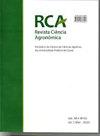酶法对甜瓜种子生理成熟度的研究
IF 0.7
4区 农林科学
Q3 AGRICULTURE, MULTIDISCIPLINARY
引用次数: 0
摘要
本文章由计算机程序翻译,如有差异,请以英文原文为准。
Study of physiological maturity of melon seeds by enzymatic changes
- Plant species have different adaptation mechanisms regarding seed survival to desiccation, preventing cellular destruction during the water loss. The knowledge of these mechanisms is of great importance for the understanding of how the seed formation/maturation processes and the processes involved in germination occur. Thus, this study aimed to determine physiological and enzymatic changes during the maturation process of melon seeds of the cultivar BRS Anton, obtained from fruits at different maturation stages and subjected to post-harvest storage, by the action of total proteins and the enzymes catalase, peroxidase, and superoxide dismutase. Melon fruits were grown in a greenhouse at Embrapa Vegetables and harvested at five different times: 30, 45, 60, 75, and 90 days after anthesis (DAA). Thirty fruits were harvested in each season and 15 fruits had their seeds extracted immediately after harvest and the other 15 fruits were stored for 15 days. After processing and drying, the seeds were submitted to the following analyses: germination, first count, protein profile analysis, and activity of antioxidant enzymes (total proteins, peroxidase, catalase, and superoxide dismutase). The activity of the antioxidant enzymes from 60 DAA under storage showed a more orderly behavior, reaffirming the results of physiological tests. It shows that the seeds at this point of physiological maturation are well-formed and drying caused no damage to their cell membranes.
求助全文
通过发布文献求助,成功后即可免费获取论文全文。
去求助
来源期刊

Revista Ciencia Agronomica
Agricultural and Biological Sciences-Horticulture
CiteScore
2.00
自引率
0.00%
发文量
41
审稿时长
4-8 weeks
期刊介绍:
To publish technical-scientific articles and study cases (original projects) that are not submitted to other journals, involving new researches and technologies in fields related to Agrarian Sciences. Articles concerning routine analysis, preliminary studies, technical notes and those which merely report laboratorial analysis employing traditional methodology will not be accepted for publication. The Journal of Agronomical Science also has the mission to promote the exchange of experience in the referred fields.
 求助内容:
求助内容: 应助结果提醒方式:
应助结果提醒方式:


